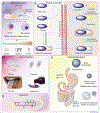The Promise of Long-Acting Antiretroviral Therapies: From Need to Manufacture
- PMID: 30981593
- PMCID: PMC6571075
- DOI: 10.1016/j.tim.2019.02.009
The Promise of Long-Acting Antiretroviral Therapies: From Need to Manufacture
Abstract
Antiretroviral therapy has transformed human immunodeficiency virus infections from certain death to a manageable chronic disease. Achieving strict adherence to drug regimens that limit toxicities and viral resistance is an achievable goal. Success is defined by halting viral transmission and by continuous viral restriction. A step towards improving treatment outcomes is in long-acting antiretrovirals. While early results remain encouraging there remain opportunities for improvement. These rest, in part, on the required large drug dosing volumes, local injection-site reactions, and frequency of injections. Thus, implantable devices and long-acting parenteral prodrugs have emerged which may provide more effective clinical outcomes. The recent successes in transforming native antiretrovirals into lipophilic and hydrophobic prodrugs stabilized into biocompatible surfactants can positively affect both. Formulating antiretroviral prodrugs demonstrates improvements in cell and tissue targeting, in drug-dosing intervals, and in the administered volumes of nanosuspensions. As such, the newer formulations also hold the potential to suppress viral loads beyond more conventional therapies with the ultimate goal of HIV-1 elimination when combined with other modalities.
Keywords: good manufacturing practices; human immunodeficiency virus type one (HIV-1); implantable devices; long-acting slow effective release antiretroviral therapy; regimen adherence; viral reservoirs.
Copyright © 2019 Elsevier Ltd. All rights reserved.
Figures




References
-
- Tatham LM et al. (2015) Nanoformulation strategies for the enhanced oral bioavailability of antiretroviral therapeutics. Ther Deliv 6 (4), 469–90. - PubMed
-
- Margolis DA et al. (2017) Long-acting intramuscular cabotegravir and rilpivirine in adults with HIV-1 infection (LATTE-2): 96-week results of a randomised, open-label, phase 2b, non-inferiority trial. Lancet 390 (10101), 1499–1510. - PubMed
-
- Ferretti F and Boffito M (2018) Rilpivirine long-acting for the prevention and treatment of HIV infection. Curr Opin HIV AIDS 13 (4), 300–307. - PubMed
-
- Williams PE et al. (2015) Formulation and pharmacology of long-acting rilpivirine. Curr Opin HIV AIDS 10 (4), 233–8. - PubMed
Publication types
MeSH terms
Substances
Grants and funding
LinkOut - more resources
Full Text Sources
Other Literature Sources
Medical
Research Materials

